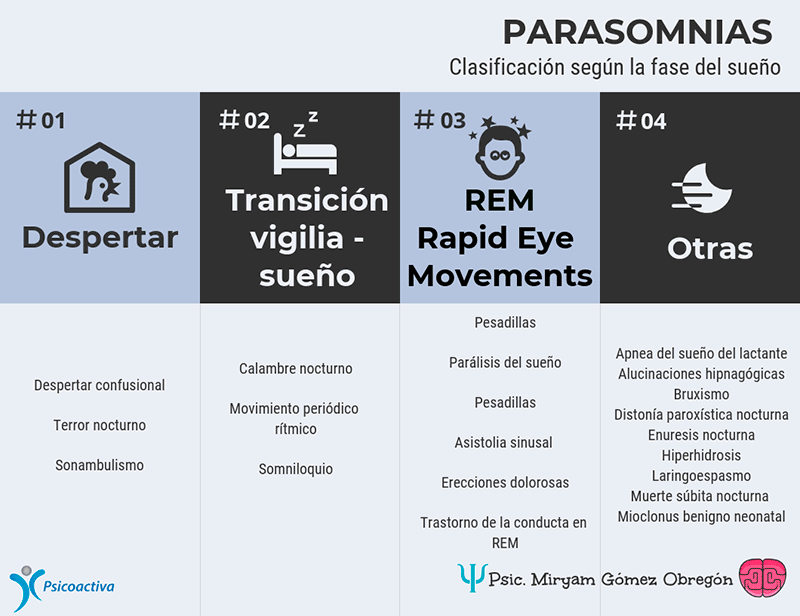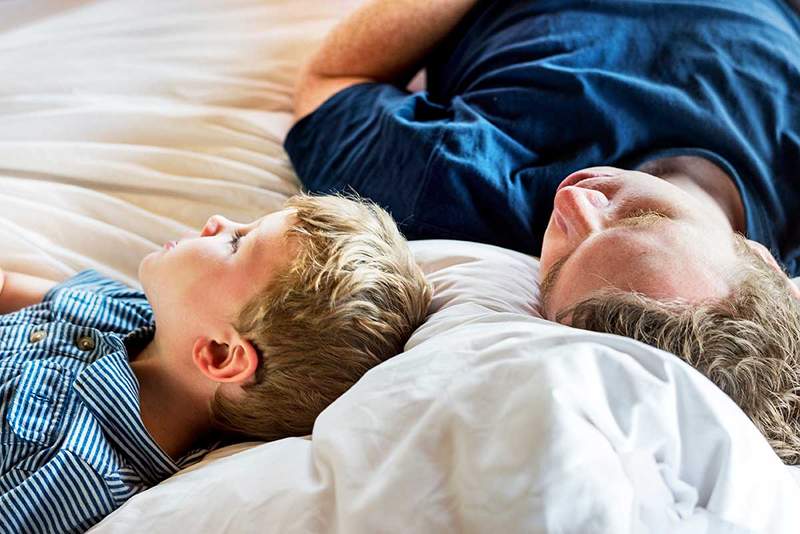The parasomnias, what are they

- 2388
- 516
- Charles Fay
The parasomnias are Clinical disorders associated with episodes or phenomena that occur in different stages of sleep, They are usually common during early childhood, in the DSM-V they are classified within sleep-vigilia disorders, they are associated with the presence of anomalous behaviors during sleep phases, some specifically on the transitions of each phase, they are usually classified according to its manifestation, which can be: When you wake up, go into sleep or during the REM phase. These dream disorders They are usually accompanied by physiological changes such as cardiovascular or muscular activation, Therefore, throughout history, they have been subject to myths.
Content
Toggle- Types of Sleep Awakening Disorders No rem
- Somnambulism
- Night terrors
- Sinister poetry of the dreamlike: nightmare disorder
- Another 9 parasomnias
- REM behavior disorder
- Somniloquios
- Bruxism
- Night enuresis
- Sexsomnia
- Night cramps
- JACTACIO Night capitis or rhythmic periodic movement
- REM sleep behavior disorder
- Sleep paralysis
- When you need to go to a professional
- Parasomnias treatment
- What happens when these resources are not enough for the person to reconcile a repair dream?
- Melatonin: sweet dreams in Morpheus's arms
- 8 tips to improve your sleep hygiene
- Electronics references
- Other references
Types of Sleep Awakening Disorders No rem
Its about Episodes recurring to awaken incomplete sleep, They usually occur during the first third of the main period of sleep, approximately when two hours after having fallen asleep, they can be accompanied by:
Somnambulism
Speavering is characterized by events in which the patient being asleep, rises and walks with some frequency. During these episodes, the individual generally has the look fixed and blank; The subjects "seem to be in trance", because they are usually insensitive to other people's efforts to communicate with him, they can wake up with difficulty and it is suggested that it be done with the suggested care.
"Midnight resting, noctámbulo being that it appears walking, at the decline of your soul it is flying .. ”Alejandro Méndez Romero
It is more common to develop during childhood, with greater recurrence between 4 and 6-8 years of age, usually disappears spontaneously in adolescence or youth; It presents it between the ONE and 15% of the general population, there is a 45% chance that a child is a sleepwalker if their parent were and if both parents were, then there is a probability of 60% that their child manifests this Parasomnia.
Night terrors
The night terrors or severe autonomic attacks, They are characterized by recurring episodes of raising sudden with terror, they usually start with panic shouts, the person who suffers them, can present muscle stiffness, have open eyes and very extensive pupils, as well as manifest behavior and wandering disorder, so who usually worry those who cohabit with them, for some injury or fall that could be caused ... possibly they can put a good scare to the person who is sleeping near the one who suffers from this parasomnia. In children, it is often.
In this type of parasomnia, there is insensitivity relative to other people's efforts to comfort the individual during episodes. In general, the amnesia of episodes is present, they do not usually remember dreams or memory is minimal. They occur in the passage from one phase from sleep to another: Rem (Rapid Eye Movements, for its acronym in English) to the non -rem phase.
During each episode of somnambulism or of night terror, There are autonomous alert signs such as: sweating, mydriasis, tachycardia and tachypnea, as well as intense fear and anguish. Episodes of parasomnias can cause clinically significant discomfort or deterioration in the social, labor or other important areas of functioning, such as cognitive, especially when they persist through long periods of time.
Sleep scarcity can cause any of our systems to begin to fail, mainly the one that controls others: the nervous system, causing in some cases the lack of emotional regulation. The immune system can also weaken for the same reason, because during sleep, the body performs important functions. In children and adolescents it is essential that the necessary strategies be established to have a Optimal sleep hygiene, since growth hormone is also secreted while sleeping; Sleeping favors muscle development and burning adipose tissue or "extra fat" in the body, another reason to lie in bed earlier and "let yourself fall into the arms of Morpheus".

Sinister poetry of the dreamlike: nightmare disorder
We have ever had a bad dream or as we usually call them, nightmares, they fulfill a physiological function and are not considered pathological, these distressing dreams are frequent in childhood, they usually begin between 3 and 6 years of age, But what is the difference between a nightmare and nightmare disorder? Clinical condition includes extremely dysphoric or Non pleasant, Generally they include threats against the safety or physical integrity of the subject, the patient can remember great fragments of the dream, can be oriented in time and space when awakening, this alteration of sleep can cause significant discomfort, deterioration in the social, labor, academic as well as other spheres in which the subject develops. Its etiology is also due to several causes, they are associated with certain unresolved conflicts, accumulated anxiety or memories of pain, among others, as in the case of victims of posttraumatic stress disorder (PTSP), where people may experience High levels of anxiety until they reach anguish and panic.
It should be specified if it is:
- Sharp: When the duration of the nightmares is a month or less.
- Subagudo: The duration of the nightmare period is greater than one month but less than six months.
- Persistent: When the duration of nightmares is equal to or greater than six months. Gravity can be classified by the frequency with nightmares:
- Mild: On average, less than one event per week.
- Moderate: Although they do not happen daily, one or more episodes occur per week.
- Serious: Nightmares occur every night.
Another 9 parasomnias
REM behavior disorder
They are like small "awakenings" that occur during REM sleep, they can be presented as a repeated episodes, they are generally associated with complex motor behaviors and vocalization, these events cause significant discomfort in the patient.
Somniloquios
In this parasomnia, the person usually speaks or verbalizes "something" when he is asleep, although sometimes he cannot be understood very well, his cause can be due to stress or inheritance: 30-50% of cases.
Bruxism
The person who sleeps involuntarily grinding from the teeth, can be corrected so that wear is not generated in the teeth, mainly molar parts; The strategies proposed by cognitive-behavioral therapy have shown to be effective in modify.
Night enuresis
It is characterized that the subject presents repeated urine broadcast, which occurs involuntarily during the night, when they are children around 5 years and that due to their age they should control their sphincters, it is important to pay attention because the inuretic problem can have its Cause or relationship with neurological, physiological or anatomical problems. It can also be even something so simple to solve, which can be modified following simple learning guidelines that a psychologist can give you, doing psychoeducation to foster sleep hygiene and even The person can be programmed at deep levels of consciousness to correct this behavior, as used within hypnosis and suggestion techniques.
Sexsomnia
When linked to some parasomnia, there is a sleep -related sexual behavior, it is called sexsomnia.
Night cramps
They have a prevalence in the high population: 15% of the population suffers from them, it is a painful sensation in muscles, which can generally be the foot, leg, thigh and family groups can affect other muscles.
JACTACIO Night capitis or rhythmic periodic movement
In these stereotyped movements, different areas of the body usually are involved, it starts before sleep and is maintained during the first phases of light sleep, they are common among neonates and during the first years of life. It has been observed that it can persist over time in people with autistic spectrum disorder (ASD) or with some type of cognitive deficit.
REM sleep behavior disorder
He R-BD sleep behavior disorder (Rapid Eye Movements-Sleep Behavoir Disorder, it is also known as Onirismo either Motor Parasomnias in Rem, It is characterized by episodes of a brief duration or several minutes, it is accompanied by increase in: muscle tone, movement and vocalizations in REM sleep, usually generates abnormal involuntary behavior such as moving in bed, kicking and walking ... sometimes it can involve behaviors aggressive or violent, which can cause injuries to others or hurt themselves.
Sleep paralysis
Sleep paralysis, they are experiencing between 40 and 50% of people who do not have any other sleep disorder, It is also called a predformal form either Hypnagogical, are Episodes where the inability to move voluntarily in the phases of sleep, When the person begins to fall asleep or when he is going to wake up ... some say, what is "When the dead is climbed”, Precisely because of that representative muscle paralysis, the distressing inability to verbalize some word or in any case some crying cry, sleep paralysis, can produce so much anxiety, which rises to panic levels, however it does not imply any phenomenon Paranormal, is caused by the Dissociation between mechanisms that produce mor (Rapid eye movements) and those that keep you in vigil. So, if something like this happens to you again: that the panic does not go! Remember that they are only short episodes and both paralysis, and the inability to verbalize soon will happen and "it is the late aunt who has come to pull your feet".
 Phobia to sleep alone
Phobia to sleep alone When you need to go to a professional
The etiology of parasomnias is generally multifactorial, special attention should be paid when there is persistence for long periods of time and this causes great discomfort or dysfunction in the patient, the Sleep disorders can become a psychiatric or neurological condition, So it is necessary to meet this important need for your body and your mind.
The "remission" of parasomnias can be spontaneous according to the child or the person continues with their development. However, treatment should be sought when there is persistence of these episodes and especially when the little one or the person, they are affected in one of the spheres in which they develop because of these dreams of sleep, since the people suffering from Parasomnias, often have the feeling of "not having rested enough", this, over time, can produce: fatigue, as well as a decrease in the performance of some cognitive functions, Some begin to be affected in academics, the work, it is necessary to think about taking treatment when there is a lack of emotional regulation, because when these phenomena prevent the person from having a repair dream, it is more feasible that the individual can begin to dysfunction in some Area, either from your body, mind or in your surroundings.
Parasomnias treatment
Recall that sleep is one of the basic human needs, so it is important! There are classical orthodox treatments, clinical experience and various research results show that some non -invasive techniques can also help induce and maintain a repair dream, without patients being affected by the side effects of drugs to reconcile sleep and without generating dependencies.
What are some treatment options that can work to improve sleep quality? There are powerful programming or suggestion techniques, which can be performed at alpha level or some deeper levels of consciousness such as beta, gamma, delta and Theta, the therapy of pressed magnetic fields, biofeedback, relaxation and meditation techniques, among many others. Likewise, cognitive behavioral therapy has shown to be highly effective, all the above can help the person having a better sleep hygiene.
What happens when these resources are not enough for the person to reconcile a repair dream?
It is necessary to go to the doctor, if you do not want to take traditional drugs to treat the dream with their respective side effects, you can ask your doctor for other alternatives: Biorregenerative medicine, provides other options such as Homotoxicology To treat some clinical disorders of sleep, contributing to regulate the systems that make it possible for your body to work properly.
Melatonin: sweet dreams in Morpheus's arms
In most cases, in adults, the use of melatonin can be indicated, which has proven to be Effective as an inductor and sleep stabilizer, thus adjusting our biological clock naturally, So, even those travelers suffering from Jet-lag For the mismatch of schedules, they can benefit from the use of it. In cases for pediatric use, melatonin can also be a good option, although very care will also have to be taken only under medical indication and monitoring, since it must have its proper indications and medical contraindications, according to many criteria they take in account the clinicians, as well as the interaction and medication synergy.
Do you feel that your body does not rest the necessary? No importing your age, if you have had problems to reconcile the dream for a while and you feel that this is affecting you in some sense, it is good that you follow your body's call towards Morpheus's arms, You may need a sleep inductor, Only a doctor can make those recommendations, although melatonin has been effective in the treatment of various conditions such as:
- Insomnia, even that caused by medications of the type of beta blockers.
- Sleeped Sleeping Phase Syndrome (DSRS)
- Epilepsy
- Migraines and other types of headaches or headaches
- Chronic fatigue
- In the case of abstinence for substance use or abuse, it can help induce sleep gradually without its use, generating another dependence on the affected patient, such as benzodiazepines, which many recommend.
8 tips to improve your sleep hygiene
- Avoid "very heavy" meals or that require a lot of energy for digestion, at least 4 hours before going to bed.
- Practice physical activity suggested by your doctor at least 5 times a week for at least 30 minutes.
- Consume Omega-3 and Triptophane.
- Melatonin consumption under medical prescription and monitoring, helps regulate sleep cycles.
- Avoid the use of screens at night near the time you go to bed, because it is highly for the brain, you can opt for some other activity such as reading in a paste book: your eyes and your brain will thank you!
- Establishes Rituals for before sleeping, After a time to practice them with determination, the programs and in the end can be installed, They can be as a sleep inductor, preparing the mind and body for rest and sleep.
- Try to go to bed an hour before the usual, it will help you add quality to your life and wake up with more energy in the morning.
- Practice breathing and relaxation exercises.
Is there any emotional discomfort, affliction or physical condition in you that turns your rest and your dreams? Do not wait any longer and seek professional help: your body, your mind and your human relationships could be diminished in the absence of it.
Electronics references
- https: // institutodelsueno.CL/Parasomnias/
- https: // vivientosans.com/melatonin-effects-secundarios/
Other references
- American Psychiatric Association (2014). DSM-5 criteria consultation guide. Washington, d.C./London, England. Editorial: Panamericana.
- ESPINAR J. 1998) Alertness Disorders and Parasomnias of the Wakefulness-Sleep Transition. Rev neurol.: 469-72.

